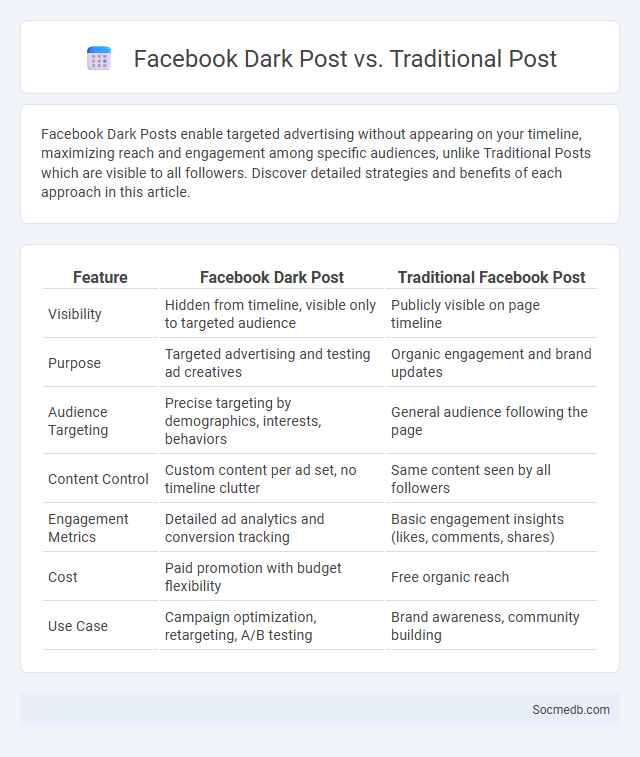
Photo illustration: Facebook Dark Post vs Traditional Post
Facebook Dark Posts enable targeted advertising without appearing on your timeline, maximizing reach and engagement among specific audiences, unlike Traditional Posts which are visible to all followers. Discover detailed strategies and benefits of each approach in this article.
Table of Comparison
| Feature | Facebook Dark Post | Traditional Facebook Post |
|---|---|---|
| Visibility | Hidden from timeline, visible only to targeted audience | Publicly visible on page timeline |
| Purpose | Targeted advertising and testing ad creatives | Organic engagement and brand updates |
| Audience Targeting | Precise targeting by demographics, interests, behaviors | General audience following the page |
| Content Control | Custom content per ad set, no timeline clutter | Same content seen by all followers |
| Engagement Metrics | Detailed ad analytics and conversion tracking | Basic engagement insights (likes, comments, shares) |
| Cost | Paid promotion with budget flexibility | Free organic reach |
| Use Case | Campaign optimization, retargeting, A/B testing | Brand awareness, community building |
Understanding Facebook Dark Posts
Facebook dark posts are unpublished ads appearing only in targeted users' news feeds, allowing precise audience segmentation without cluttering public pages. These posts enable advertisers to conduct A/B testing and tailor content for specific demographics, optimizing engagement and conversion rates. By leveraging Facebook's ad manager tools, marketers gain granular control over campaign performance and budget allocation.
Traditional Facebook Posts Explained
Traditional Facebook posts are user-generated content typically comprising text, images, videos, or links shared on a user's timeline or page. These posts drive engagement through likes, comments, and shares, forming the foundation of Facebook's social ecosystem. Understanding the algorithms prioritizing recent, relevant, and interactive traditional posts can enhance visibility and audience reach.
What Is a Dark Post on Facebook?
A dark post on Facebook is a type of unpublished ad that does not appear on the advertiser's timeline or page but is shown directly to a targeted audience in their news feed. These ads enable marketers to run multiple versions of a campaign simultaneously, optimizing for engagement and conversion without cluttering their main page. Utilizing dark posts helps businesses tailor messages to specific demographics, increasing ad relevance and improving return on investment (ROI).
Key Differences: Dark Post vs Traditional Post
Dark posts on social media are unpublished, targeted ads that only appear in specific users' feeds, allowing precise audience segmentation without cluttering the main page. Traditional posts are organic content visible publicly on a brand's timeline, engaging followers broadly and enhancing overall page presence. Dark posts enable A/B testing and direct response marketing, whereas traditional posts build brand identity and community interaction.
Advantages of Using Facebook Dark Posts
Facebook Dark Posts enable precise audience targeting, increasing ad relevance and engagement without cluttering the brand's public timeline. These unpublished posts support A/B testing and campaign optimization by allowing marketers to run multiple ad variations seamlessly. Utilizing dark posts maximizes advertising efficiency through enhanced control over ad delivery to specific demographics, interests, and behaviors.
When to Use Traditional Facebook Posts
Traditional Facebook posts are most effective for engaging a broad audience with general updates, announcements, or sharing multimedia content like photos and videos. They work well during peak activity times, such as weekday afternoons and early evenings, to maximize reach and interaction. Utilizing traditional posts helps maintain consistent brand presence and fosters community engagement without the need for immediate ad spend.
Targeting and Audience Segmentation
Effective social media marketing relies heavily on precise targeting and audience segmentation to reach specific demographics, interests, and behaviors. By leveraging data analytics and platform algorithms, brands can create tailored content that resonates with distinct audience segments, increasing engagement and conversion rates. Tools such as Facebook Audience Insights and Instagram's detailed targeting options enable advertisers to refine campaigns based on age, location, purchase intent, and online activity patterns.
Measuring Performance: Dark vs Traditional Posts
Measuring performance of social media content reveals significant differences between dark posts and traditional posts, with dark posts offering more precise targeting and detailed analytics. Dark posts, often used in paid advertising, enable marketers to test content variations without cluttering public profiles, providing clearer insights into audience engagement and conversion metrics. Traditional posts rely on organic reach, making it harder to isolate performance due to broader visibility and interaction variables.
Cost Efficiency and ROI Comparison
Social media marketing offers unmatched cost efficiency, enabling businesses to reach vast audiences with targeted campaigns at a fraction of traditional advertising costs. Platforms like Facebook and Instagram provide detailed analytics to track engagement, which helps optimize your ad spend for maximum return on investment (ROI). Comparing ROI across different social media channels reveals that strategic investment in content creation and audience targeting significantly boosts profitability while minimizing expenditure.
Choosing the Right Strategy for Your Goals
Choosing the right social media strategy involves identifying your specific goals, whether increasing brand awareness, driving website traffic, or boosting sales. You must analyze your target audience's preferences and behaviors on platforms like Instagram, LinkedIn, or TikTok to tailor content effectively. By aligning your strategy with measurable objectives and key performance indicators, you ensure your social media efforts deliver meaningful results for your business.
 socmedb.com
socmedb.com